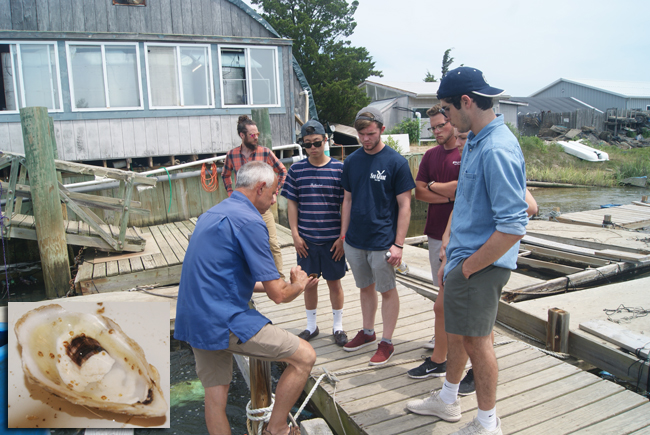
Sea Grant student interns observe Gregg Rivara, site director at the Suffolk County Marine Environmental Learning Center (SCMELC) in Southold, NY. SCMELC is headquarters to the Cornell Cooperative Extension Marine Program's Aquaculture Program, which includes several shellfish hatcheries and nursery areas. Inset: Interns are looking at oyster spat on an oyster shell. Spat are the juvenile oysters that will eventually grow to full size. Credit: Michael Ciaramella/NYSG.
— By Chris Gonzales, Freelance Science Writer, New York Sea Grant
Stony Brook, NY, March 24, 2019 - The oyster industry on eastern Long Island is enjoying a renaissance. Several new companies have formed in the last decade or so, and the number of aquaculture permits requested by individuals for off-bottom shellfish cultivation is up. Indeed, across the wider region, according to the East Coast Shellfish Growers Association, oyster production has doubled in the past five years; the entire regional shellfish aquaculture industry now brings to market $150 million worth of raised oysters, clams, and mussels, as well as wild-caught scallops1. Most of the farms are small enterprises with fewer than 10 employees2.
Key to the oyster industry is what insiders call “seed,” the juvenile oysters that eventually grow into adults. Parent oysters need a lot of energy to spawn, and young oysters need a lot to grow. Energy, or nutrients, for these organisms typically come from food in the form of live microalgae, which is expensive for small hatcheries to obtain and maintain in quantity.
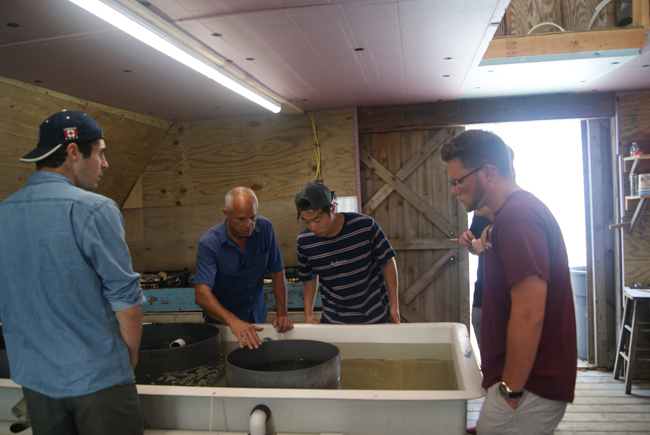
Sea Grant student interns explore the sustainable shellfish hatchery. This facility, run by a small group of Cornell Cooperative Extension staff and volunteers, raises mainly oysters, but also other types of shellfish. The hatchery is located in Southold, in the northeastern tip of Suffolk County on the North Fork of Long Island. Credit: Michael Ciaramella/NYSG.
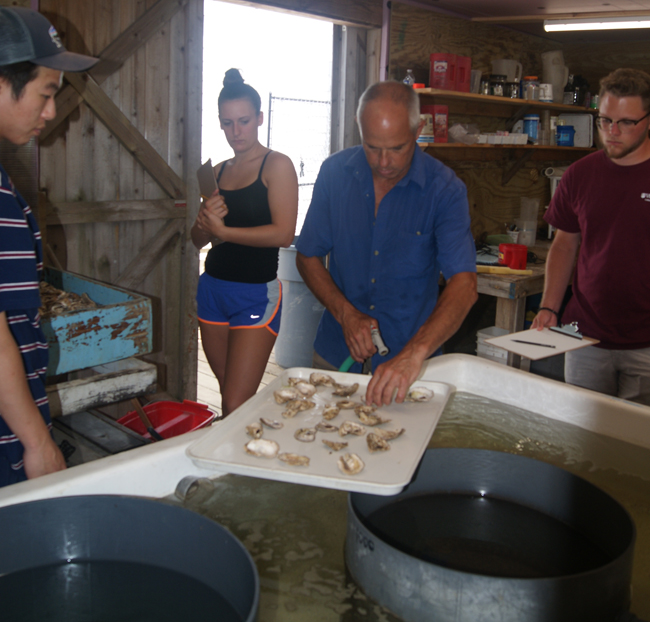
A tray contains oyster shells that were selected randomly to observe the spat on them. Once rinsed, they will be taken into the lab to count the number of larval oysters per shell. Credit: Michael Ciaramella/NYSG.
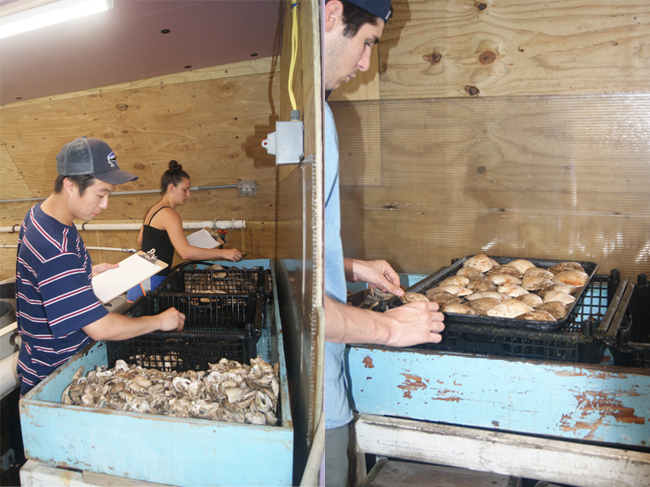
Interns count the number of whole shells of both oysters and clams. Credit: Michael Ciaramella/NYSG.
With funds from New York Sea Grant, investigators Gregg Rivara and Kim Tetrault explored the use of commercially available algal concentrates to take the place of live algae in hatcheries on Long Island.
They wanted to know how larval growth would compare when given algal concentrate only, live algae only, or a 50/50 mix.
They found in all experimental settings, in all hatcheries, the “live only” feeding ration always outperformed any other feeding regime. It produced larger, healthier larvae more capable of metamorphosing into spat and adults. While using algal concentrate doesn’t kill or harm larvae, the resulting shellfish were smaller and less vibrant. While there is clearly a cost to feeding live algae, in terms of labor, energy, and production space and equipment, the benefits warrant the expense. Thus, production hatcheries worldwide likely will continue using some form of a live algae diet rather than a mix of concentrates.
However, there may be a role for the algal concentrates in getting through a tight patch when live stock is unavailable.

Interns count oyster larvae on clam shells. Credit: Michael Ciaramella/NYSG.
“Growing larvae doesn't require nearly as much live algae as feeding post-set juveniles or conditioning broodstock [parent oysters] for spawns,” said Tetrault. “Algal concentrates are extremely useful to cover the requirements for these hatchery endeavors.”
“Using concentrates are useful for broodstock conditioning as this is typically started early in the season when live algae cultures aren’t fully up and running,” added Rivara.
These strategies could be particularly useful for small hatcheries, which often need to obtain live algae from outside sources.
“This culture season, I fed 250,000 1 mm oyster seed that I had obtained in mid-March on a diet of 100% concentrate,” Tetrault added. “While they did not effectively grow—volumes stayed essentially the same for four weeks—they did not die and were able to go on ambient water in mid-April where they survived and grew well into late spring and early summer.”
He added that stocks that were put on ambient water in mid-March due to insufficient room in the hatchery did not survive the harsh cold of that particular year.
The concentrate diet could be an extremely valuable alternative to new growers wishing to purchase early small seed and for hatchery operators that are not able to feed all of the early cohorts.
In the future, the researchers hope further trials could help manufacturers and hatcheries understand the best use of mixed live and concentrate diets.
Footnotes
1 East Coast Shellfish Growers Association, 2017 Legislative Priorities (pdf) Accessed November 5, 2018.
2 East Coast Shellfish Growers Association, Best Management Practices for the East Coast Shellfish Aquaculture Industry (pdf) Accessed November 5, 2018.
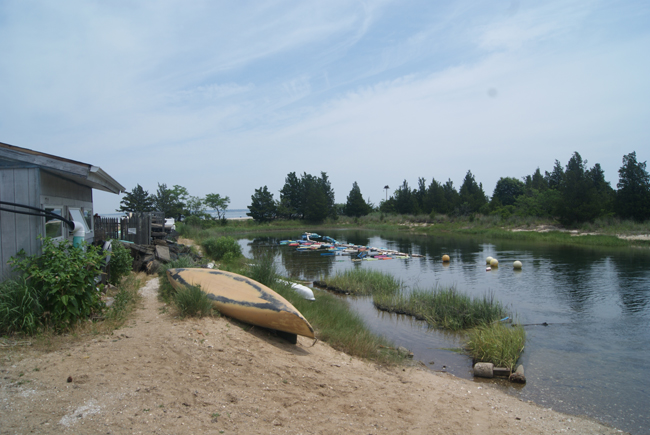
The views are rather scenic at the hatchery, out in Southold on Long Island's East End. Credit: Michael Ciaramella/NYSG.
More Info: New York Sea Grant
New York Sea Grant (NYSG), a cooperative program of Cornell University
and the State University of New York (SUNY), is one of 33 university-based
programs under the National Oceanic and Atmospheric Administration’s
National Sea Grant College Program.
Since 1971, NYSG has represented a statewide network of integrated
research, education and extension services promoting coastal community
economic vitality, environmental sustainability and citizen awareness
and understanding about the State’s marine and Great Lakes resources.
Through NYSG’s efforts, the combined talents of university scientists
and extension specialists help develop and transfer science-based
information to many coastal user groups—businesses and industries,
federal, state and local government decision-makers and agency managers,
educators, the media and the interested public.
The program maintains Great Lakes offices at Cornell University, SUNY
Buffalo, SUNY Oswego and the Wayne County Cooperative Extension office
in Newark. In the State's marine waters, NYSG has offices at Stony Brook
University in Long Island, Brooklyn College and Cornell Cooperative
Extension in NYC and Kingston in the Hudson Valley.
For updates on Sea Grant activities: www.nyseagrant.org has RSS, Facebook, Twitter, and YouTube links. NYSG offers a free e-list sign up via www.nyseagrant.org/nycoastlines for its flagship publication, NY Coastlines/Currents, which is published quarterly. Our program also produces an occasional e-newsletter,"NOAA Sea Grant's Social Media Review," via its blog, www.nyseagrant.org/blog.